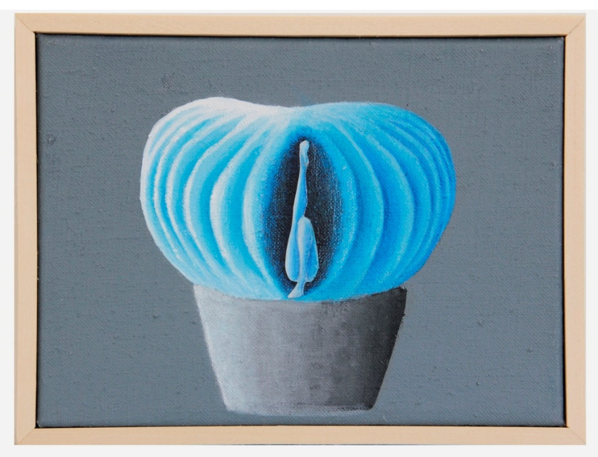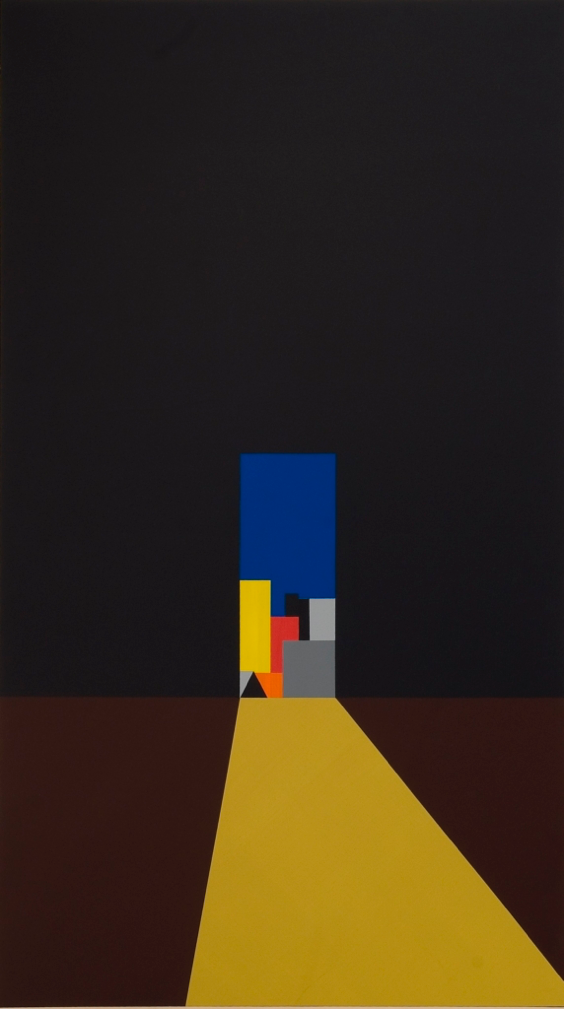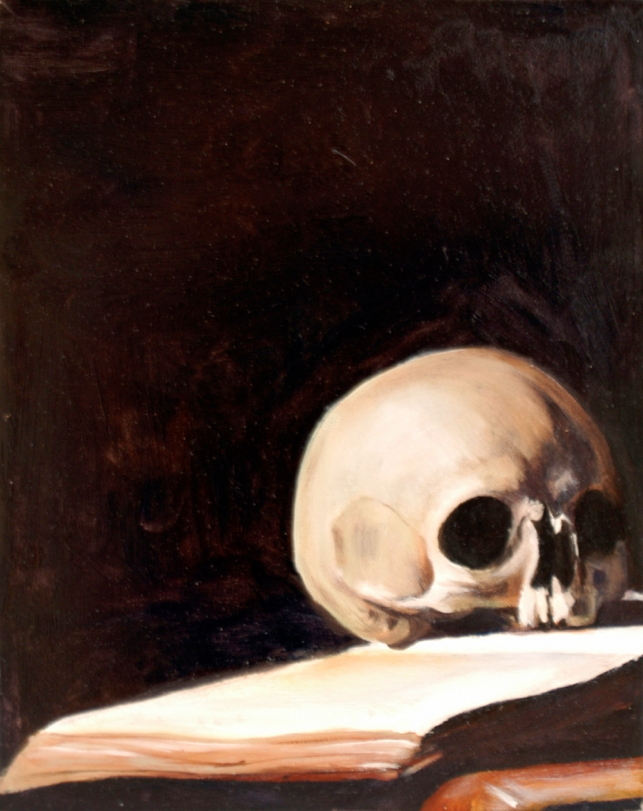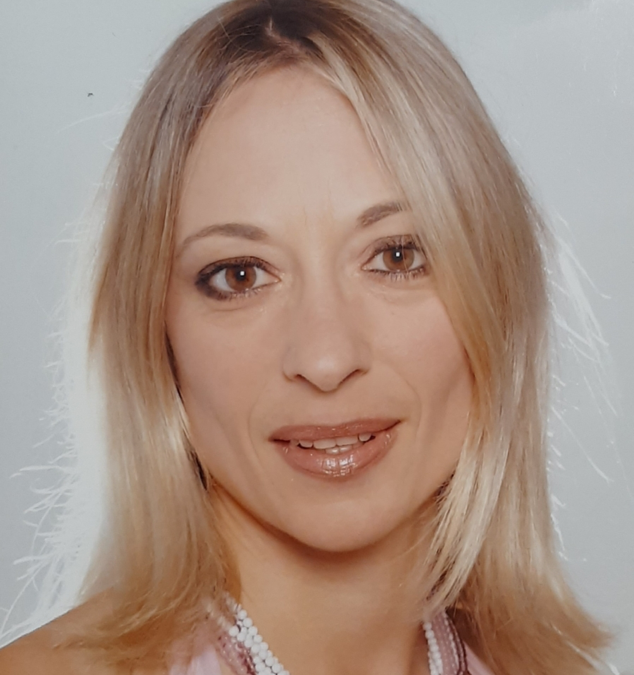Origini italo-tedesche, nata a Roma ma, seguendo l’indole naturale insita nel suo appartenere a due culture diverse sebbene complementari, trasferitasi presto all’estero per continuare i suoi studi artistici ma anche per approfondire la conoscenza di se stessa in virtù dell’interazione con l’altro, con il diverso da sé, Federica Scoppa manifesta nelle sue opere l’apertura mentale che contraddistingue chi sceglie di abbandonare il terreno familiare, quello in cui sarebbe più facile accomodarsi, per esplorare il mondo intorno, per mettersi in discussione e scoprire modi differenti di essere, di pensare, di parlare. Dopo dieci lunghi anni durante i quali si è compiuta la sua ricerca personale e artistica decide di rientrare in Italia, inizialmente a Roma dove si iscrive all’Accademia di Belle Arti per concretizzare il suo percorso formativo e successivamente a Venezia, dove attualmente vive e lavora, città in cui consegue il diploma e che ritiene essere il suo posto, quello in cui stabilirsi e continuare a perseguire il suo sogno di vivere della sua arte. Dal punto di vista creativo la Scoppa rivela una personalità forte eppure delicata, empatica, volta all’osservazione concettuale della realtà circostante, mostrando uno stile aperto all’interpretazione non solo di ciò che vede ma anche alla consapevolezza che ogni accadimento, ogni evento, può essere il risultato e la conseguenza del precedente. La leggerezza contraddistingue le sue tele, quella morbidezza necessaria ad aprirsi al succedersi degli eventi ma anche all’interpretazione poliedrica di tutto ciò che entra a far parte, per un istante o per un frangente più lungo, della vita di ciascuno e che non può avere un punto di vista univoco perché altrimenti risulterebbe limitante, ingabbiante all’interno di uno schema mentale che non si apre al possibilismo. Gli strati che a volte si sovrappongono sono una metafora della stessa esistenza, quell’interagire costante tra persone che entrano ed escono dalle porte scorrevoli della vita altrui e che in qualche modo lasciano il loro segno, vivace oppure più delicato ma sempre in grado di portare un elemento, uno spunto di riflessione e di arricchimento essenziale per la maturazione di un pensiero e di un approccio più elevati, più consapevoli, maggiormente predisposti alla conoscenza e all’implementazione della propria crescita. La sua cifra pittorica è affine all’Espressionismo Astratto sebbene in qualche modo Federica Scoppa lo superi tralasciando l’irruenza del Dripping e la meditazione del Color Field per dar vita a tele in cui la curiosità empatica è al centro della ricerca dell’artista così come la riflessione sulle complicazioni dell’esistenza contemporanea, le sue costanti interazioni e sovrapposizioni,

gli scontri tra differenti modi di essere si intersecano lasciando traccia del loro passaggio come inconsapevoli segni indelebili all’interno della vita del singolo. La gamma cromatica scelta dalla Scoppa è variegata, in alcune tele tenue e impalpabile, quasi un gioco di trasparenze e di evidenze, in altre invece più vivace, dinamica, effervescente,

e poi ci sono quelle in cui i graffi del grattage appaiono come una necessità di incidere sui colori i segni degli accadimenti che in qualche modo marcano il tempo e l’interiorità malgrado la consapevolezza di dover andare oltre. Federica Scoppa ha all’attivo molte mostre personali e collettive su tutto il territorio italiano e le sue opere hanno vinto diversi riconoscimenti. Ora però andiamo a scoprire di più su questa delicata e sensibile artista, direttamente dalla sua viva voce.
Allontanarsi dal proprio paese di origine e vivere calati in una realtà culturale diversa è sempre fonte di arricchimento, ci racconta quanto e come quell’esperienza è stata incisiva nella scelta del suo approccio pittorico? Quali emozioni vorresti trasmettere mediante le tue opere?
Sono partita per la Germania intorno ai trent’anni, curiosa ed entusiasta dell’avventura che mi apprestavo a intraprendere e alla ricerca di un’identità non solo pittorica ma anche personale, umana, un percorso che è durato ben dieci anni. Prima di fare quel salto nel buio percepivo di girare intorno al raggiungimento della pienezza artistica e personale, ero in una spirale, sulla strada giusta ma fagocitata dalla quotidianità; spesso la vista era annebbiata, il turbinio degli avvenimenti era molto incalzante perché molteplici erano le distrazioni in una città vivace come Roma, così come la fagocitante azienda di famiglia non mi permettevano di avere quella lucidità necessaria a capire quale direzione volessi davvero prendere. Quindi non restava che partire. Mi liberai di tutto, il destino mi aiutò, la morte del mio cane a cui ero immensamente legata, il distacco dall’eterno fidanzato e dall’azienda di famiglia mi hanno portata all’estero, dove ho avvertito il bisogno di fare tabula rasa, di iniziare a scrivere il secondo capitolo della mia vita. I ventotto anni sono emblematici, si dice che ogni sette anni cambiamo pelle e che ogni quattordici anni si verificano per ciascun individuo cambiamenti epocali. Ecco, miei ventotto anni hanno segnato la strada da intraprendere, quella che ancora sto seguendo.
L’Espressionismo Astratto ha costituito il termine di un percorso oppure è un inizio da cui sente di poter evolvere? È un arrivo oppure una tappa cui seguirà una nuova sperimentazione? Quali sono gli artisti del passato o del presente a cui si sente più affine o che la ispirano di più?
L’Espressionismo Astratto non segna la fine di un percorso, come non lo è stata la figurazione. Il mezzo espressivo è al servizio del mio pensiero perché il gesto artistico nasce da un’esigenza. L’essere artista astratta o figurativa è una scelta razionale dettata dalla trasmissione di un pensiero. Lavorare su tela o vetro, oppure con l’argilla, dipingere un quadro oppure installare una serie di opere è per me un mezzo per comunicare al fruitore la mia riflessione che può essere sociale, come nei quadri della serie Cactus, in cui medito sui femminicidi,

oppure su ciò che vediamo affacciandoci alla finestra come nella serie Windows, o ancora un mio punto di vista sulle relazioni umane come nella serie Intrecci, e ancora sul mondo e sulla natura come nella serie Worlds. Quindi astrazione e figurazione si intersecano, si sovrappongono, si escludono e includono. Mi sono ispirata a tanti artisti, come Michelangelo e Caravaggio, per la figurazione o a Paul Klee, Viktor Vasarely, Robert Ryman, Mark Rothko, Gerhard Richter, per l’astrazione o il Gesamtwerk (Rothko e Richter nello specifico), e poi, ovviamente, alle talentuose donne del passato e della contemporaneità come Tamara de Lempicka, Rebecca Horn, Marina Abramovic, Nan Goldin

Lei ha compiuto, con coraggio e determinazione, la scelta di vivere della sua arte: quali difficoltà ha incontrato durante il suo percorso? Ritiene che nella contemporaneità sia più complicato o più semplice decidere di fare arte in modo professionale, rispetto al secolo scorso?
Ne ho incontrato tantissime di difficoltà: prima di tutto per essere donna. Tutt’oggi nell’arte contemporanea le artiste di rilievo sono ancora in numero molto inferiore rispetto agli uomini, perché non è semplice dividersi tra il realizzare e gestire la propria figura artistica e la famiglia. Così come non facile doversi occupare di un bambino piccolo, dipingendo e tenendolo avvolto sulla schiena per molti mesi o chiedendogli, una volta cresciuto, di cenare mangiando un tramezzino preso al bar perché la mamma sta terminando un’opera, o aiutare i figli a fare i compiti tra argilla e polvere, colori e trementina. A volte mi sono trovata a scegliere se comprare un pennello di Martora Kolinsky o un giocattolo per il mio bambino. Tuttavia, negli ultimi anni qualcosa ha iniziato a muoversi, ho avuto la fortuna di incontrare virtualmente la gallerista italiana ma residente a Düsseldorf Francesca Della Ventura, che ha fondato la InWomen.Gallery, una galleria d’arte che si occupa di arte al femminile e che devolve una parte degli introiti ricavati dalla vendita delle opere a progetti e associazioni che sostengono le donne nel mondo. Sicuramente dal Novecento la figura dell’artista supportato da un mecenate che gli commissionava le opere in esclusiva ha smesso di esistere; oggi l’artista ha la più completa libertà creativa; tuttavia, allo stesso tempo deve fare i conti con le varie crisi economiche, tra cui questa recentissima legata al Covid-19. Sappiamo bene che la cultura è stata la prima ad andare in lockdown e l’ultima a essere liberata e questo ha portato molti artisti a entrare in una fase di stallo economico. Quel periodo di isolamento forzato è stato per me un momento estremamente introspettivo e profondo a seguito del quale ho creato la mostra Worlds – After Covid-19 che si può visitare sul mio sito web.
Nel corso della sua carriera ha partecipato a numerose mostre collettive su tutto il territorio nazionale ricevendo apprezzamenti da pubblico e critica: qual è stata la sua soddisfazione più grande? Quali sono i suoi prossimi progetti?
Non posso dire che ci sia stata una mostra più importante di un’altra. Alcune esposizioni sono state fondamentali dal punto di vista della critica d’arte perché accompagnate da numerosi articoli. Altre invece hanno confermato una tendenza positiva in termini di vendite. Certamente in una mostra personale riuscire a vendere il trenta per cento delle opere esposte è una grande soddisfazione! Ma certo non è solo questo. È altrettanto appagante esporre in una prestigiosa galleria, o avere una fondazione che ti chiama per l’acquisizione di un’opera oppure società che ti chiede di interpretare pittoricamente il loro concept.

Durante ogni mostra mi sento veramente felice, quando vedo tutti i quadri appesi e quando tutto è pronto e si sta per alzare il sipario e il pubblico comincia a entrare; sento profonda gratitudine per le persone che rendono ogni mostra un evento unico e speciale, dal gallerista ai critici che mi seguono e scrivono per il catalogo, al webmaster che aggiorna il sito, come al webdesigner che mi crea il catalogo, alla fotografa, al tipografo, se non ci fossero tutte queste persone non ci potrebbe essere una mostra. Progetti ne ho tantissimi, in cantiere ho ben sette mostre. Mi devo solo mettere all’opera sperando che, in questi tempi così duri per l’arte, questo sia possibile.
FEDERICA SCOPPA-CONTATTI
Email: artef19@yahoo.it
Sitoweb: https://www.scoppa.it/
Facebook: https://www.facebook.com/artef19
Instagram: https://www.instagram.com/scoppafederica/
MARTA LOCK’S INTERVIEWS:
FEDERICA SCOPPA, WHEN EMPATHIC APPROACH BECOMES ART
Of German-Italian origin, she was born in Rome but, following the natural character inherent in her belonging to two different yet complementary cultures, she soon moved abroad to continue her artistic studies but also to deepen her knowledge of herself by virtue of her interaction with others, Federica Scoppa shows in her artworks the open-mindedness that characterises those who choose to leave familiar ground, where it would be easier to settle, to explore the world around them, to question themselves and discover different ways of being, thinking and speaking. After ten long years of personal and artistic research, she decided to return to Italy, initially to Rome, where she enrolled at the Academy of Fine Arts to complete her training, and then to Venice, where she currently lives and works, the city in which she obtained her diploma and which she considers to be her place, the one in which to settle and continue to pursue her dream of living from her art. From a creative point of view, Scoppa reveals a strong yet delicate, empathetic personality, aimed at the conceptual observation of the surrounding reality, showing a style open to the interpretation not only of what she sees but also to the awareness that every happening, every event, can be the result and consequence of the previous one. Lightness distinguishes her canvases, that softness necessary to open up to the succession of events but also to the multifaceted interpretation of everything that becomes part, for an instant or for a longer period, of everyone’s life and that cannot have a single point of view because otherwise it would be limiting, caging it within a mental scheme that is not open to possibility. The layers that sometimes overlap are a metaphor for existence itself, that constant interaction between people who enter and leave the sliding doors of the lives of others and who somehow leave their mark, whether it is lively or more delicate but always capable of bringing an element, a point of reflection and enrichment essential for the maturation of a higher, more conscious thought and approach, more predisposed to knowledge and to the implementation of one’s own growth. Her pictorial style is similar to Abstract Expressionism, although in some ways Federica Scoppa goes beyond it, leaving aside the impetuosity of dripping and the meditation of the colour field to create canvases in which empathic curiosity is at the heart of the artist’s research, as is reflection on the complications of contemporary existence, its constant interactions and overlaps, the clashes between different ways of being that intersect, leaving traces of their passage as unconscious indelible marks within the life of the individual. The range of colours chosen by Scoppa is varied, in some canvases soft and impalpable, almost a game of transparencies and highlights, in others more lively, dynamic, effervescent, and then there are those in which the scratches of the grattage appear as a need to engrave on the colours the signs of events that in some way mark time and interiority despite the awareness of having to go beyond. Federica Scoppa has had many solo and group exhibitions throughout Italy and her artworks have won various awards. But now let us find out more about this delicate and sensitive artist, directly from her own voice.
Moving away from your country of origin and living in a different cultural reality is always a source of enrichment. Can you tell us how much and how this experience influenced the choice of your pictorial approach?
I left for Germany around the age of 30, curious and enthusiastic about the adventure I was about to embark on and in search of an identity that was not only pictorial but also personal and human, a journey that lasted ten years. Before taking that leap into the dark, I felt that I was circling the drain of artistic and personal fulfilment, I was in a spiral, on the right path but engulfed by everyday life; my vision was often blurred, the whirlwind of events was very pressing because there were so many distractions in a lively city like Rome, just as the engulfing family business did not allow me to have the lucidity necessary to understand which direction I really wanted to take. So all that remained was to leave. I got rid of everything, fate helped me, the death of my dog to whom I was immensely attached, the separation from my eternal boyfriend and the family business took me abroad, where I felt the need to wipe the slate clean, to start writing the second chapter of my life. Twenty-eight years is emblematic, it is said that every seven years we change our skin and that every fourteen years epochal changes occur for each individual. Well, my twenty-eight years have marked the road to take, the one I am still following.
Was Abstract Expressionism the end of a journey or is it a beginning from which you feel you can evolve? Is it an arrival or a stage that will be followed by new experimentation? Which artists from the past or present do you feel closest to or most inspired by?
Abstract Expressionism does not mark the end of a path, just as figuration did not. The expressive medium is at the service of my thought because the artistic gesture is born from a need. Being an abstract or figurative artist is a rational choice dictated by the transmission of a thought. Working on canvas or glass, or with clay, painting a picture or installing a series of works is for me a means of communicating my thoughts to the viewer. These thoughts can be social, as in the paintings in the Cactus series, in which I meditate on feminicide, or on what we see when we look out of the window, as in the Windows series, or my point of view on human relationships, as in the Intrecci series, or on the world and nature, as in the Worlds series. So abstraction and figuration intersect, overlap, exclude and include each other. I have been inspired by so many artists, such as Michelangelo and Caravaggio, for figuration, or Paul Klee, Viktor Vasarely, Robert Ryman, Mark Rothko, Gerhard Richter, for abstraction or Gesamtwerk (Rothko and Richter specifically), and then, of course, by the talented women of the past and present such as Tamara de Lempicka, Rebecca Horn, Marina Abramovic, Nan Goldin.
You made the choice to live off your art with courage and determination: what difficulties have you encountered along the way? Do you think it is more complicated or easier to decide to make art professionally now than it was in the last century?
I have encountered many difficulties: first of all, being a woman. Even today, there are still far fewer women artists in contemporary art than men, because it is not easy to divide your time between making and managing your artistic work and your family. Just as it is not easy to have to take care of a small child, painting and keeping him wrapped up on your back for many months or asking him, once he has grown up, to eat dinner with a sandwich from the café because his mother is finishing an artwork, or to help your children with their homework amidst clay and dust, paint and turpentine. Sometimes I found myself choosing between buying a Kolinsky Marten brush or a toy for my child. However, in the last few years something has started to move. I had the good fortune to virtually meet the Italian art dealer living in Düsseldorf, Francesca Della Ventura, who founded the InWomen.Gallery, an art gallery that focuses on women’s art and donates part of the proceeds from the sale of the artworks to projects and associations that support women around the world. Certainly since the 20th century, the figure of the artist supported by a patron who commissioned his works exclusively has ceased to exist; today the artist has complete creative freedom, however, at the same time he must come to terms with the various economic crises, including this most recent one linked to Covid-19. We know very well that culture was the first to go into lockdown and the last to be liberated, and this has led many artists to enter an economic deadlock. That period of enforced isolation was an extremely introspective and profound moment for me as a result of which I created the exhibition Worlds – After Covid-19 which can be visited on my website.
During your career, you have taken part in numerous group exhibitions throughout Italy, receiving praise from both the public and the critics: what has been your greatest satisfaction? What are your next projects?
I cannot say that there has been one exhibition more important than another. Some exhibitions were fundamental from the point of view of art criticism because they were accompanied by numerous articles. Others have confirmed a positive trend in terms of sales. Certainly in a solo exhibition, being able to sell thirty per cent of the artworks on display is a great satisfaction! But of course that is not all. It is just as satisfying to exhibit in a prestigious gallery, or to have a foundation call you to acquire an artwork or a company to ask you to interpret their concept pictorially. During each exhibition I feel really happy, when I see all the paintings hanging and when everything is ready and the curtain is about to be raised and the public begins to enter; I feel profound gratitude for the people who make each exhibition a unique and special event, from the gallery owner to the critics who follow me and write for the catalogue, to the webmaster who updates the website, as well as the webdesigner who creates the catalogue, the photographer, the printer, if there were not all these people there could not be an exhibition. I have so many projects, I have seven exhibitions in the pipeline. I just have to get to work and hope that, in these hard times for art, this will be possible.
CONTATTI
Tel: 351 5531169

